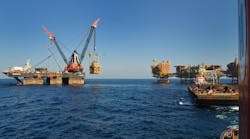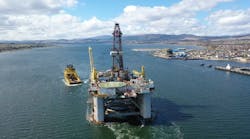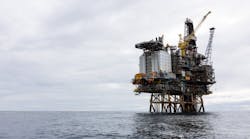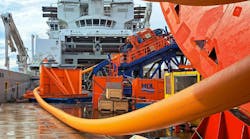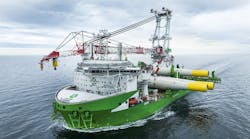In mid-December, the Bureau of Ocean Energy Management (BOEM) announced that it had administratively increased the limit of liability for oil-spill related damages from $75 million to approximately $134 million for offshore oil and gas facilities.
The change to BOEM's regulations was proposed last February, and the bureau says it fully considered all stakeholder comments before enacting this rule, which will go into effect in January 2015.
The BOEM says that the increase is consistent with recommendations to increase the liability cap from the National Commission on the BP Deepwater Horizon Oil Spill and other studies and represents the maximum increase allowable under the Oil Pollution Act of 1990.
"BOEM is taking an important step to better preserve the "polluter pays" principle of the Oil Pollution Act and further promote safe and environmentally responsible operations," said Acting Director Walter Cruickshank. "This is the first administrative adjustment since the Oil Pollution Act was enacted in 1990 and is needed to keep pace with inflation, which has increased 78% since then."
The administrative adjustment to the Oil Pollution Act of 1990 liability cap for offshore facilities is based on the significant increase in the Consumer Price Index (CPI) that has occurred since 1990. The liability cap is set by statute and may only be adjusted to address significant increases in the CPI. The increase to $134 million represents the maximum increase that may be implemented absent new legislation.
The increase applies to facilities handling oil and gas in federal and state waters seaward of the coastline. The liability cap applies to damages that result from oil spills, but does not apply to other liabilities such as oil spill removal costs, which remain unlimited. The rule also contains a mechanism to regularly update the limit of liability cap in the future to reflect changes in inflation over time based on the CPI.
Freeport-McMoRan reports drilling results
Freeport-McMoRan Oil & Gas says it has received positive drilling results from its 100%-owned Holstein Deep and Dorado development wells in the deepwater GoM. Production from these projects is expected to total 30,000 boe/d in 2016.
During 4Q 2014, the Holstein Deep delineation well in the Green Canyon area reached a TD of 31,100 ft (9,479 m). Recent wireline logs and core data combined with previous results confirm that the well encountered a total of 234 net ft (71 net m) of Miocene oil pay with excellent reservoir characteristics and good correlation to the discovery well and previous confirmation side track drilling.
Production from the planned three-well development is expected to reach 15,000 boe/d in 2016 and will tieback to the existing Holstein production facility. Based on the results from the delineation well, FM O&G has increased the net unrisked resource potential of the Holstein Deep field to more than 250 MMboe from the previous estimate of 140 MMboe. The data also supports the potential for additional development opportunities at Holstein Deep with up to 75,000 boe/d production by 2020.
The Holstein Deep development is in Green Canyon block 643, west of the Holstein platform in 3,890 ft (1,186 m) of water. FM O&G acquired the acreage a 2013 lease sale held by the Bureau of Ocean Energy Management.
FM O&G has identified multiple additional development opportunities in the Green Canyon area that could be tied back to the Holstein facility.
The company also reported positive drilling results at the 100%-owned Dorado development, which began drilling in October. In December, the well reached a TD of 14,600 ft (4,450 m) and encountered 245 net ft (75 net m) of Miocene pay with excellent reservoir characteristics and good correlation to offset productive wells. This is the first of three wells planned for subsea tieback to the Marlin facility targeting undrained fault blocks and updip resource potential south of the Marlin facility.
Production from the planned three-well Dorado development is expected to reach 15,000 boe/d in 2016 and will tieback to the existing Marlin production facility. The Dorado development is located on Viosca Knoll block 915 in 3,860 ft (1,177 m) of water. FM O&G has a 100% working interest in Marlin.
UT to lead study on methane hydrates
A research team led by The University of Texas at Austin has been awarded approximately $58 million to analyze deposits of frozen methane under the Gulf of Mexico that hold enormous potential to increase the world's energy supply.
The grant, one of the largest ever awarded to the university, will allow researchers to advance scientific understanding of methane hydrate, a substance found in abundance beneath the ocean floor and under Arctic permafrost.
The Department of Energy is providing $41,270,609, with the remainder funded by industry and the research partners.
In addition to UT Austin's Institute for Geophysics (UTIG) at the Jackson School of Geosciences, the study includes researchers from The Ohio State University, Columbia University's Lamont-Doherty Earth Observatory, the Consortium for Ocean Leadership, and the U.S. Geological Survey.
Hess, partners sanction Stampede development
Hess Corp. and its partners will proceed with the development of the Stampede project in the deepwater GoM.
Development plans for Stampede call for six subsea production wells and four water injection wells from two subsea drill centers tied-back to a TLP. A two-rig drilling programs is planned with the first rig commencing operations in 4Q 2015. First production is slated for 2018.
Gross topsides processing capacity for the project is about 80,000 b/d of oil and 100,000 b/d of water injection. Total estimated recoverable resources for Stampede are estimated in the range of 300-350 MMboe/d. Development is expected to cost $6 billion.
Discovered in 2005, Stampede is situated 115 mi (185 km) south of Fourchon, Lousiana, in Green Canyon blocks 468, 511, and 512. The field lies in about 3,500 ft (1,067 m) of water with a reservoir depth of 30,000 ft (9,144 m).
Hess has a 25% working interest in the project and is operator. Union Oil Co. of California, a Chevron subsidiary; Statoil; and Nexen Petroleum Offshore U.S.A. Inc. each have a 25% working interest.
Mexico announces shallow-water bid plans
Mexico is taking one of the first action steps in its energy reform by offering 14 shallow-water exploration and production contracts for bids.
Reuters reports the 14 contracts cover 4,222 sq km (1,630 sq mi) in Mexican territorial waters in depths between 131 and 262 ft (40 and 80 m). Oil companies will be able to access data rooms containing seismic and other geological data for the areas from Jan. 15 through July 14.
Details on the bidding are expected to be released over the next few days. Mexico has said that the winning bids will be those that offer the government the largest share value of any produced hydrocarbons plus the minimum required investment.
"There's a great expectation that these areas will be able to produce oil for Mexico in a relatively short period of time," said Juan Carlos Zepeda, president of the National Hydrocarbon Commission. According to Reuters he also said that several of the blocks up for grabs likely hold significant quantities of light crude oil.


